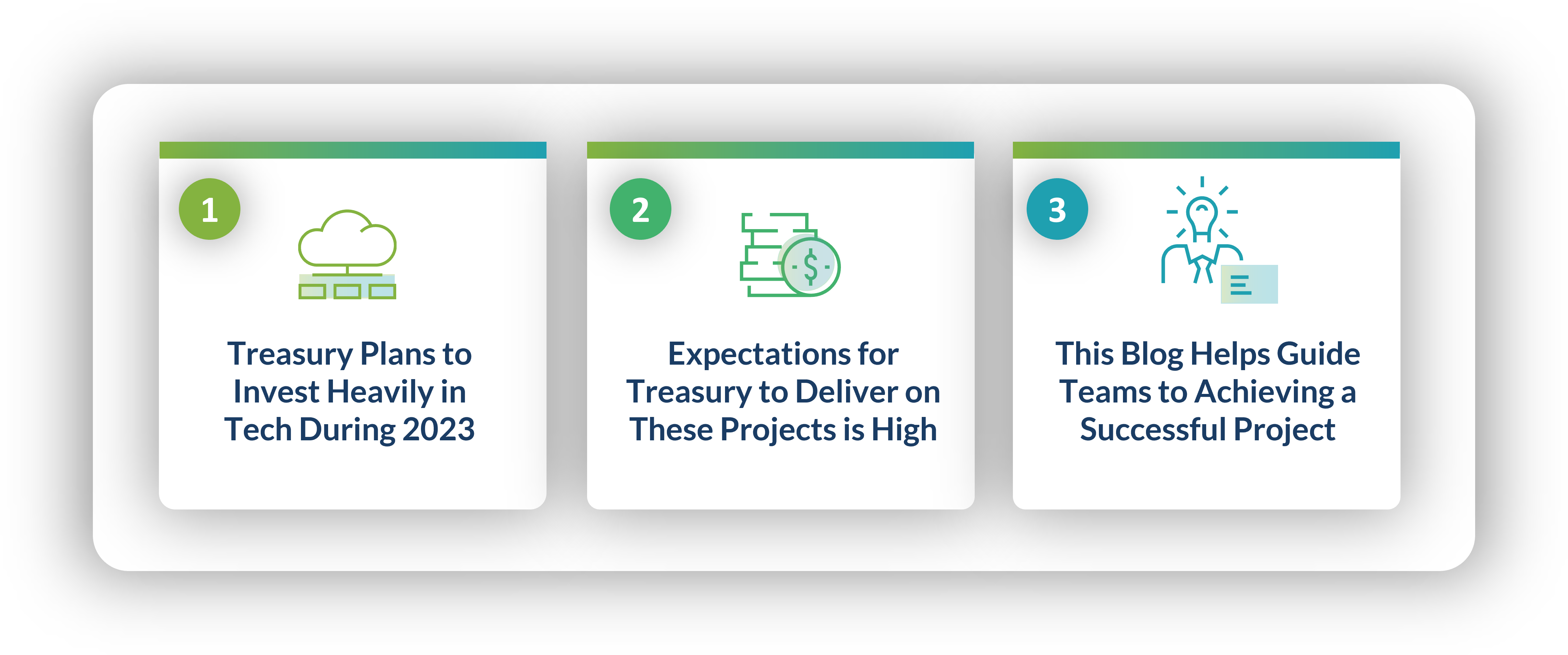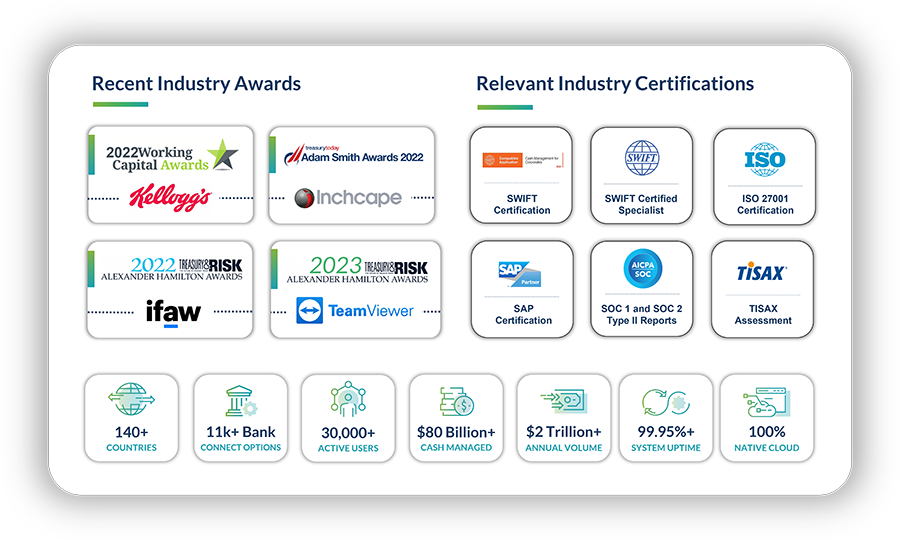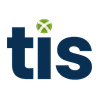In 2023, data shows that treasury teams are expected to continue investing significantly in new technology solutions. These plans include the adoption of new ERP and TMS solutions as well as more “disruptive” technologies like artificial intelligence (AI) and machine learning (ML). As practitioners and business leaders prepare their budget and move forward with their selections, the following questions can be used as a guide for determining the key ingredients of a successful project. Our hope is that this list will help treasury refine their strategy for securing project approval, collaborating with other internal stakeholders, preparing an RFP or RFI, measuring the ROI of their project, and planning for onboarding to avoid hurdles and common sources of delay.
Context: Treasury’s Technology Spend Remains Elevated in 2023
Despite the economic headwinds that have impacted much of the global business environment throughout 2022 and early 2023, data from recent months has shown that treasury groups are still planning to invest significantly in both additional headcount and new technology. As evidence, a recent TIS survey found that at least 40% of practitioners were expecting to bolster their technology stack across numerous functions in 2023, with a focus on areas like cash management, forecasting, working capital, payments, and security. Additional research from prominent industry bodies like AFP and Strategic Treasurer have yielded similar results.
However, in order for these technology projects to have the desired effect and yield positive results, treasury teams must be very strategic and intentional with their approach. Because there are a variety of internal and external challenges that can obstruct an onboarding timeline, it’s critical for organizations to perform as much due diligence as possible before the project kicks off. It’s also important to collaborate with other internal stakeholders ahead of time to ensure adequate buy-in, approval, and planning. To help treasury walk through all the potential factors that could impact their project, the following questions can serve as a point of reference.

15 Questions for Treasurers to Ask Themselves & Their Vendors During Technology RFPs & Implementations
1. What is typically included in a request for proposal (RFP) or request for information (RFI) as treasury groups begin the technology selection process? How is this process managed? How many vendors should be considered?
RFIs and RFPs delivered by treasury to potential vendors often request information related to the scope of capabilities offered by each vendor, as well as info related to their size, location(s), staff count, client base / composition, revenue, and ownership structure. Additional questions related to the hosting setup, pricing schema, customer support structure, and onboarding approach are also common. Although the number of vendors included in an RFP or RFI varies, what’s important is that practitioners include enough options to establish an adequate understanding of what’s available in the market, without overwhelming themselves with an excessive number of applicants. In most cases, practitioners may reach out to 10-15 vendors before creating a shortlist of 3-5 and taking a more comprehensive look into these select few before making a final selection.
2. What other internal stakeholders should be involved in a treasury technology implementation or onboarding project?
Commonly, treasury will need to work with their CFO as well as peers in accounting, IT, AP, AR, Legal, and HR to ensure a successful project. For the most part, collaborating with other financial departments will center on ensuring adequate buy-in and approval, with ample consideration of how it will benefit all of these stakeholders, and not just treasury. At the same time, treasury must plan to work with accounting and AP to determine how the new solution will integrate with existing processes and systems to streamline communication, reporting, and payment workflows. Regarding IT, treasury must pay careful attention to ensure that any required in-house configuration or support is properly planned for and documented, especially in cases where internal bandwidth is already constrained. And finally, Legal assistance will be needed to review contracts and ensure compliance, while HR teams may support by managing user permissions and admin roles as the new solution goes live.
3. How can treasury most effectively ensure buy-in from other stakeholders for their projects, including the CFO, AP, and Accounting?
Showcasing the benefits that a treasury new solution will provide to other stakeholders in terms of improved reporting, more accurate data, faster insights, cost-savings, or greater control and security will all go a long way in winning approval. It is recommended that treasury approach their peers, particularly in accounting, AP, and IT, long before an RFP or RFI is launched to learn more about the needs of other departments and determine how any new solution they implement could also work to address their requirements. For instance, identifying ways that the adoption of a treasury solution that offers real-time financial reporting and payments workflows will help accounting, AP, and the CFO all better perform their own responsibilities can make a huge impact in winning their support. And if a CFO also sees widespread support for a project internally and understands that the benefits are multifaceted, there will be much greater impetus to push forward. Similarly, if IT understands up-front what their responsibilities are and has time to plan, there will be much less confusion and delay after the project begins.
4. How should treasury balance collaboration with their IT teams, banks, and vendors when handling onboarding and other configuration tasks?
Given the predominantly cloud-based era of treasury software that exists today, practitioners may find that a growing proportion of onboarding and implementation tasks can be handled by the vendor’s team, rather than their own. However, there will almost certainly be tasks that are assigned to themselves and internal IT, and there’s also the potential for banking partners and other external sources to be involved as well. If treasury plans to connect their new solution with various banks and back-office platforms – including those at other entities – then the effort required by all associated teams will become more significant. For this reason, treasury should take great care to determine exactly which components of the process will be delegated to each internal and external group, as well as how long each task will take (if possible) and where in the overall process each step is positioned. Once the project starts, having these steps clearly assigned and documented will help keep everyone aligned with what the priorities are, even if certain steps ultimately get delayed.
5. Bank connectivity and financial messaging can be two of the most complicated aspects of a treasury technology project. What are some best practices to ensure these components do not get out of hand, especially as new connectivity options and standards are introduced?
Because of the broad range of bank connectivity options (SWIFT, EBICS, SFTP, API, etc.) and various financial messaging standards (SWIFT MT, ISO 20022, EDI, BAI, etc.) that exist across the landscape, it can be difficult for treasury to ensure compatibility with each unique option they must support. This is especially true if their organization is operating in multiple world regions with unique payment methods and reporting formats that are used in each case. During implementations where each bank partner, system, and format must be supported by the new platform, the complexity of working with each stakeholder to configure and test all these connections becomes a source of significant pain. To alleviate this, it’s highly recommended that treasury identify a solution that offers specialized support for bank connectivity and financial messaging as a standard service. It’s also recommended that treasury give their bank partners ample forewarning before a project of this magnitude starts, so that they can plan accordingly to assist in the process. Often, many of the hurdles experienced during a largescale project are the result of delays on the banking side, so collaborating with your institutions is crucial for ensuring that projects stay on-schedule and within budget.
6. How are pricing and fee structures in the treasury technology market typically managed? How does pricing relate to the number of users, payment volumes, data storage, subscriptions fees, onboarding fees, etc.?
Today, pricing for new solutions and capabilities in the treasury technology market can vary quite substantially. For instance, there are usually fees associated with an onboarding or implementation project, as well as monthly or annual subscription fees for hosting services. Additional fees related to the number of users onboarded, the number of capabilities purchased, and the volume of data or payments that flow through the platform can all potentially be added as well. Ongoing customer service and support fees are another consideration. Because of the disparity and diverse range of pricing schemas, it’s essential for treasury to carefully evaluate each vendor they are considering to determine how the pricing will vary. It’s also important to analyze how different offerings provided by a specific vendor can alter the price of their package, as there may be opportunities for discounts when purchasing or combining certain services.
7. How do you ensure that treasury teams are trained and equipped to use new software solutions effectively? What role should the vendor play in this process?
Ironically, one of the biggest impediments to long-term success of treasury technology projects is that treasury personnel are never adequately trained to use what they purchased. To avoid this issue, treasury should stress up-front training on the solution with the vendor throughout the onboarding process, as well as for an extended period of support during the first few weeks and months after go-live. It is also recommended that treasury work to schedule regular training touchpoints with the vendor as new capabilities are deployed or new personnel are hired so that their team always has the most up-to-date and comprehensive understanding of the tools at their disposal. In large part, it will be up to the vendor to help facilitate these resources, either through online educational resources, in-person trainings, annual client conferences, or otherwise.
8. What do most treasury technology project timelines look like? Are most projects managed through a “phased” approach, and if so, how are these phases planned?
Because treasury technology projects can focus on a broad variety of different functions and solution types, there is no “one-size-fits-all” approach to implementations. Instead, the projects are usually scheduled and phased depending on the scope of what’s included. For instance, projects that focus only on a few core functions and that don’t involve complex integrations or bank connections may be completed in a single phase that takes just a few months or weeks, while more complex projects can easily stretch across multiple years and contain numerous phases and milestones. Although the unique implementation plan decided on by treasury and their vendor will likely look different for each new project that is undertaken, it’s worth noting that the more parties (i.e. banks) and functions that are included in a project, the greater the chance that delays or unforeseen hurdles will impact the timeline. So, it’s important to perform significant due diligence as the timeline and milestones are created to ensure that these types of issues are accounted for.
9. What level of emphasis should practitioners place on the customer support / issue resolution capabilities of their treasury software vendor?
The competency of customer support services across the treasury environment is largely unstandardized. While some vendors may offer 24/7 phone, chat, and email support across all world regions for all clients, others may only offer 24/5 support or just limited email and chat options. In addition, some vendors provide a dedicated contact to each client who is responsible for managing issues and resolutions, while others may direct all clients to a single hotline where new resolutions are centrally managed. Furthermore, certain vendors may create tiers of support where clients can pay extra for more comprehensive service options. And finally, some vendors prefer to outsource their support functions to 3rd party partners and consultants, while others may maintain an exclusively in-house team. Again, given the disparity of options that exist in this regard, it’s vital that practitioners pay attention to the level of service they will receive both during onboarding and beyond, as this can have a significant impact on the ROI received through the solution, especially if bugs or issues start to arise.
10. How can treasury professionals maximize data accuracy and integrity when integrating multiple systems that span numerous entities, departments, and banks?
Today, there are a broad variety of connectivity and integration options available to corporates for streamlining communication between their systems. On the banking side, this includes SWIFT, EBICS, SFTP, API, and more (plus a variety of financial messaging standards), while on the systems side, SFTP and API connections remain the two most common methods. Although the use cases for each option can vary, it’s common for companies to utilize a combination of all these methods simultaneously, with different integrations used in unique circumstances. However, as a general rule, treasury should try to eliminate as many manual touchpoints and sources of data entry error as possible, and should also work to ensure that same-day, intra-day, or real-time feeds can be developed to improve the efficiency of communication between their systems. From a security standpoint, ensuring that SAML and various forms of hashing and data encryption exist on all integrations and exchange options is another critical point of emphasis, as the opportunity for fraud and security lapses can easily manifest themselves in poorly configured integrations and connection points.
11. How do different fintechs and financial institutions handle data security, and what measures should treasury professionals take to protect sensitive information?
The topic of data and payments security within treasury is a comprehensive one that spans all aspects of their technology, including basic login functions on company hardware and software, as well as advanced user and system monitoring. Forms of data encryption and hashing protocols are common mechanisms deployed. While the workflows and tools used by each company will vary, it’s generally recommended that treasury adopt a multifaceted suite of complimentary solutions that address security at every juncture, from the time employees login to their systems to the time payments and reports are exchanged. Workflows to guard data at rest and in transit should also be incorporated, as well as clear and streamlined processes for handling alerts, notifications, and resolutions for any potential issues or hazards that occur, especially for those involving system breaches or suspicious payments activity.
12. How do regulatory requirements and compliance standards impact the selection and implementation of treasury solutions?
Similar to the above, treasury groups must often deal with a complex set of regulatory, sanctions, and compliance restrictions that shift depending on which industries and regions they operate in. Typically, these regulations impact how data is transmitted and stored, as well as how payments are executed and cash is managed. At a minimum, treasury should ensure that core certifications for ISO 27001 and SOC I / SOC II compliance have been met by their vendors as standard provisions for their software, but they may also need functionality-level compliance concerns addressed for managing FBAR, OFAC / EU sanctions, and other data-related protocols like GDPR. While most vendors will offer standard compliance certification and licenses out of necessity, more advanced sanctions and compliance modules or FBAR and eBAM tools are less standardized, and treasury’s unique need for these solutions should be evaluated closely alongside the other capabilities offered by each vendor.
13. How do you determine the right level of customization and configuration for a treasury management solution?
While it’s unlikely that a vendor will be able to configure an entirely unique solution or offering for each client they service, there are still very large differences in the level of customization that is afforded to clients by certain vendors. This is true across numerous facets of the technology market, including which payment options are offered, which financial messaging formats and standards are supported, which bank connect options are available, how many users can be added, which security tools can be integrated, and more. As a general rule, it should be expected that vendors can customize sub-components of their product to fit unique needs, and any vendor that pushes back unnecessarily against customization requests should be evaluated more closely to determine if they are capable of supporting all of treasury’s requests.
14. How can treasury ensure that they do not adopt redundant or unnecessary features when implementing new solutions?
A few years ago, data from a Strategic Treasurer survey showed that an astonishing 6 out of 10 treasury groups were leveraging less than 80% of the functionality they purchased originally with their TMS. Furthermore, nearly 4 out of 10 were leveraging less than 60% of their functionality. While these figures have improved since the original study, there is still a significant industry issue resulting from the misuse or “oversell” of various modules and capabilities. Unfortunately, there is no easy way to solve this after a project is complete, save for undergoing additional work to remove certain functions or restructuring workflows to eliminate redundancies. So, it’s imperative that before a project is started, treasury undergo a thorough evaluation of their existing technology setup, as well as the capabilities inherent in their new solution, to determine exactly what will be needed and what can be addressed through other options. It’s also important to discuss with each vendor what functionalities are required to be purchased and which are optional, as there are often a core suite of modules that must be implemented in order for the solution infrastructure to function as intended.
15. How do you measure the success and ROI of a treasury management software implementation?
The unique KPIs and ROI measurements used by treasury groups vary broadly, but the most common ones revolve around analysis of savings with regards to technology fees, transaction costs, banking services, and licensing or hosting expenses. Similarly, measuring time-savings for treasury groups, IT teams, and other stakeholders as a result of added automation and efficiency from the solution is a common practice, as is the measurement of any boost in revenue through more effective working capital, payments, or cash management strategies. Finally, for companies that emphasize fraud, security, and compliance, ROI could revolve around the ability to protect against exposures, avoid financial losses, and prevent sanctions or regulatory issues.
Final Thoughts: How TIS Helps Your Organization Transform Payments, Liquidity, & Cashflow
As treasury teams evaluate the above questions and move forward with their projects, we invite any company in need of enhanced payments, banking, liquidity, cashflow, security, or compliance capabilities to strongly consider the SaaS platform and services offered by TIS.
Since 2010, TIS’ award-winning cloud platform and best-in-class service model have empowered the entire office of the CFO to collaborate more effectively and attain maximum efficiency, automation, and control. By streamlining connectivity between our customers’ back-office systems and their worldwide banks, vendors, and business partners, TIS enables users to achieve superior performance in key areas surrounding cash forecasting, working capital, outbound payments, financial messaging, fraud prevention, payment compliance, and more.
With over 11,000 banking options, $80 billion in daily cash managed, and $2.5 trillion in annual transaction volume, TIS has a proven track record of combining our unparalleled market expertise with tailored client and community feedback to drive digital transformation for companies of all sizes and industries. As a result, hundreds of organizations and thousands of practitioners rely on TIS daily to gain strategic advantage, monetize data, improve operational efficiency, and better manage risk.
For more information, visit tispayments.com and explore how our innovative solutions can help you transform your digital treasury environment. You may also schedule a call with one of our experts to learn more about the technical components of our platform. We hope to hear from you soon, and best of luck on your next project!
Notice: Certain segments of this blog were developed using ChatGPT, an AI-based language modeling service. If you have questions about the use of ChatGPT in this resource, please contact our Content Director at isaac.zaubi@tispayments.com



